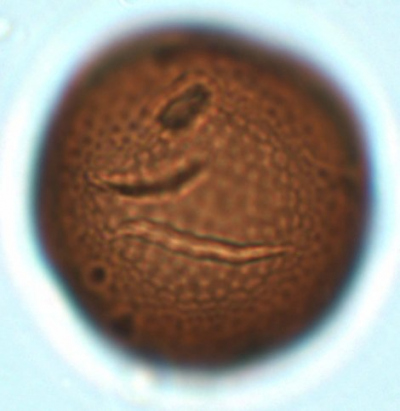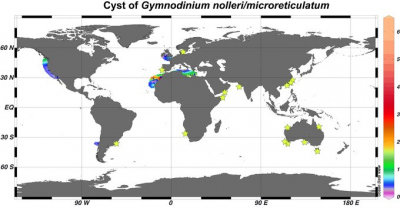Die Inhalte dieser Seite sind leider nicht auf Deutsch verfügbar.
Seitenpfad:
- Modern Dinocyst Key
- brown cysts
- round brown with septa, reticulation, double wall
- reticulate cysts
- Cyst of Gymnodinium microreticulatum
Cyst of Gymnodinium microreticulatum
Zonneveld, K.A.F. and Pospelova V. (2015). A determination key for modern dinoflagellate cysts. Palynology 39 (3), 387- 409.

photograph Karin Zonneveld
Field characteristics
Cyst of Gymnodinium microreticulatum Bolch, Negri and Hallegraef 1999
Field characteristics:
Spherical resting cysts with a wall that is pale brown to purplish brown and is covered with a network of raised ridges, forming a pattern of polygonal reticulations that reflect amphyesmal vesicles of the vegetative cells. Features outlined include the cingulum, sulcus and para-apical groove. The cingulum is delineated on both the apical and antapical sides by two rows of flattened paravesicles. On the apical side, the first (external to cingulum) row of paravesicles is compressed and pentagonal, meeting the next to roughly square (internal) paravesicles along a straight margin that definish the upper margin of the paracingulum. The antapical (lower) side is defined by two identically oriented rows of paravesicles, such that the internal row is pentagonal and the external row is squared. On this lower margin, the pentagonl row is less compressed than those forming the upper margin. Germination of the cyst is through a chasmic archeopyle. The archeopyle is usually, but not always, oriented along the sulcal line on the cyst, extending from the apical grove around to the antapex Bolch et al., 1999.
Dimensions: Cyst body diameter 17 to 28 µm (Bolch et al, 1999)
Cyst theca relationship: Bolch et al., 1999
Comparison with other species:
This species can be distinguished from cysts of G. catenatum and G. nolleri by its smaller size, its cingulum that is larger that 25% of the cyst body and its archeopyle that is usually along the sulcus.
Field characteristics:
Spherical resting cysts with a wall that is pale brown to purplish brown and is covered with a network of raised ridges, forming a pattern of polygonal reticulations that reflect amphyesmal vesicles of the vegetative cells. Features outlined include the cingulum, sulcus and para-apical groove. The cingulum is delineated on both the apical and antapical sides by two rows of flattened paravesicles. On the apical side, the first (external to cingulum) row of paravesicles is compressed and pentagonal, meeting the next to roughly square (internal) paravesicles along a straight margin that definish the upper margin of the paracingulum. The antapical (lower) side is defined by two identically oriented rows of paravesicles, such that the internal row is pentagonal and the external row is squared. On this lower margin, the pentagonl row is less compressed than those forming the upper margin. Germination of the cyst is through a chasmic archeopyle. The archeopyle is usually, but not always, oriented along the sulcal line on the cyst, extending from the apical grove around to the antapex Bolch et al., 1999.
Dimensions: Cyst body diameter 17 to 28 µm (Bolch et al, 1999)
Cyst theca relationship: Bolch et al., 1999
Comparison with other species:
This species can be distinguished from cysts of G. catenatum and G. nolleri by its smaller size, its cingulum that is larger that 25% of the cyst body and its archeopyle that is usually along the sulcus.
Geographic distribution
Geographic distribution based on :
Zonneveld et al., 2013. Atlas of modern dinoflagellate cyst distribution based on 2405 datapoints. Review of Palaeobotany and Palynology, v. 191, 1-197
Gymnodinium nolleri and Gymnodinium microreticulatum is observed in coastal sites of temperate to sub-tropical, oligotrophic to mesotrophic regions which are full marine and have bottom waters which are moderately to well ventilated.
Zonneveld et al., 2013. Atlas of modern dinoflagellate cyst distribution based on 2405 datapoints. Review of Palaeobotany and Palynology, v. 191, 1-197
Gymnodinium nolleri and Gymnodinium microreticulatum is observed in coastal sites of temperate to sub-tropical, oligotrophic to mesotrophic regions which are full marine and have bottom waters which are moderately to well ventilated.

Distribution:
Cysts of Gymnodinium nolleri/microreticulatum are observed in coastal sediments from temperate to sub-tropical regions of the eastern Atlantic Ocean and adjacent seas such the Mediterranean Sea, and the eastern Pacific. Highest abundances up to 6% occur off NW Africa.
Environmental parameters:
SST: 8.0 - 28.7°C (winter - summer) and SST > 14.0°C in summer. Exception is formed by one site in the northeastern Pacific where SST: -1.3, -0.8, 4.4 and -0.8°C (winter, spring, summer, autumn). SSS: 31.2 - 38.8 (winter - summer) except for one northeastern Pacific site where SSS: 26.8 in summer. [P]: 0.08 - 1.1 μmol/l, [N]: 0.18 - 6.95 μmol/l, chlorophyll-a: 0.1 - 15.9 ml/l, bottom water [O2]: 1.1 - 6.1 ml/l.
Abundances >2% occur when SST: 24.2 - 28.7°C (winter - summer). Highest relative abundances are observed oligotrophic/mesotrophic regions where bottom waters are moderately to well ventilated.
Comparison with other records:
Cysts of G. nolleri/microreticulatum have additionally been registered from coastal sites of the Skagerrak (Ellegaard and Moestrup, 1999; Harland and Nordberg, 2011), the western South Atlantic, the East China Sea and South China Sea, the Arabian Sea and around Australia/Tasmania (Bolch and Reynolds, 2002). A seasonal distribution study in Lisbon Bay (Portugal) documents that production occurs mainly in winter/early spring (Ribeiro and Amorim, 2008).
Cysts of Gymnodinium nolleri/microreticulatum are observed in coastal sediments from temperate to sub-tropical regions of the eastern Atlantic Ocean and adjacent seas such the Mediterranean Sea, and the eastern Pacific. Highest abundances up to 6% occur off NW Africa.
Environmental parameters:
SST: 8.0 - 28.7°C (winter - summer) and SST > 14.0°C in summer. Exception is formed by one site in the northeastern Pacific where SST: -1.3, -0.8, 4.4 and -0.8°C (winter, spring, summer, autumn). SSS: 31.2 - 38.8 (winter - summer) except for one northeastern Pacific site where SSS: 26.8 in summer. [P]: 0.08 - 1.1 μmol/l, [N]: 0.18 - 6.95 μmol/l, chlorophyll-a: 0.1 - 15.9 ml/l, bottom water [O2]: 1.1 - 6.1 ml/l.
Abundances >2% occur when SST: 24.2 - 28.7°C (winter - summer). Highest relative abundances are observed oligotrophic/mesotrophic regions where bottom waters are moderately to well ventilated.
Comparison with other records:
Cysts of G. nolleri/microreticulatum have additionally been registered from coastal sites of the Skagerrak (Ellegaard and Moestrup, 1999; Harland and Nordberg, 2011), the western South Atlantic, the East China Sea and South China Sea, the Arabian Sea and around Australia/Tasmania (Bolch and Reynolds, 2002). A seasonal distribution study in Lisbon Bay (Portugal) documents that production occurs mainly in winter/early spring (Ribeiro and Amorim, 2008).


